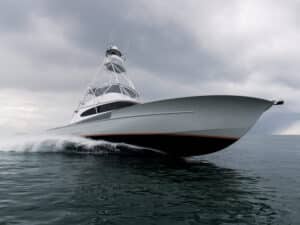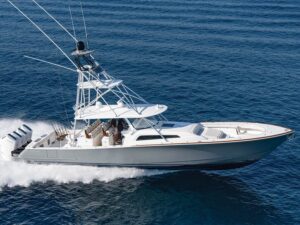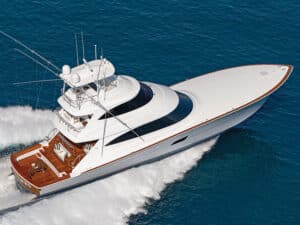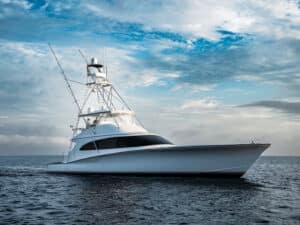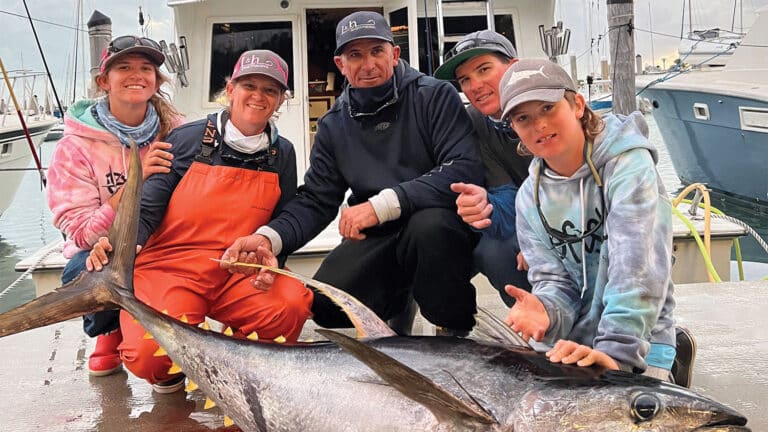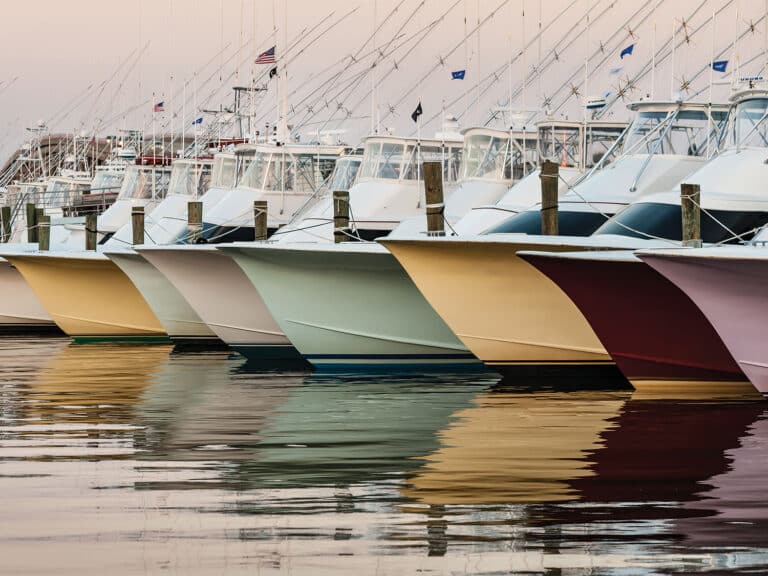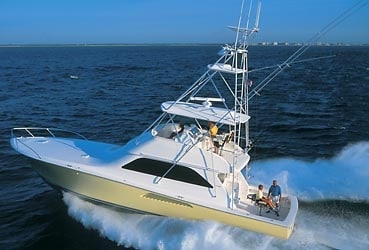
The Vikings were a legendary seafaring people. They charted new territories. They visited America long before Columbus was born. They were ferocious warriors in battle and rarely came out of a skirmish in second place. Yep Viking Yachts is aptly named.
**Performance **Viking boats are known for running fast and handling seas with aplomb. The new 52 continues the Viking family heritage with no apologies. If the power-assist steering were any more sensitive or responsive, it would react to your pulse. Slow-speed performance also shines, with spinning and backing down accomplished more quickly than an angler could reel.
The Viking 52 exhibits little bow rise when coming up onto plane and continues to run with a flat inclination angle. The running surface has received some changes over previous Vikings, such as narrowed and re-angled chines for a smoother ride and for channeling spray downward, respectively. With a northwest wind blowing at 15 knots, we didn’t have to go far offshore before the flat seas along Singer Island, Florida, picked up to 4 to 6 feet. While trolling in the beam sea off Jupiter as well as when kite fishing, the Viking 52 showed remarkable roll stability.
Glendining electronic controls allow super-smooth throttle and gear movement as well as synchronizing and trolling/low-idle modes. MAN engines (both the standard 10-cylinder models and the 12-cylinder optional power plants our test boat sported) feature a low-speed function where one bank of cylinders drops out at lower speeds to conserve fuel.
The Viking 52 also responds amazingly well to a turn of the wheel at idle speeds quite an uncommon ability. Down-sea and in quartering seas at 30 knots, the 52 tracked perfectly. So here’s the bottom line on performance: Driving the Viking 52 poses so little challenge that a skilled helmsman could quickly become bored.
I found this Viking to have what seemed a comparatively small wake running at 37 knots. And at trolling speed, you couldn’t ask for more pronounced, clear alleys in which to run your baits.
**Flybridge **As elsewhere, Viking provides storage in all the usual places on the flybridge. Viking always gives the helmsman superior visibility in all directions. A scallop in the forward brow dramatically improves your view of the bow. Standing at the helm, you can see the aft half of the fighting chair and cockpit. And finally, the ergonomics of the helm station could hardly be improved. The outboard half of the console cants aft for easy access and better display viewing. Everything is within easy reach without your needing to leave the wheel. Being safety-conscious, I also appreciated the ladder to the tower. It has enough room to climb comfortably, yet it’s tight enough to feel secure a masterful bit of engineering.
**Cockpit **Everywhere you look aboard this Viking, a sense of stark cleanliness overwhelms you. This is especially true in the cockpit. Hidden storage for gaffs, mops, shore cables and hoses abound under the gunwales. The modules for the deep freeze, tackle center, engine-room access and the like have no visible latches, and since everyone sits on the modules anyway, I fancied the cushions Viking included there.
About the only improvements I would like to see here apply not only to Viking, but to all convertible sport-fishermen: First, there’s never a dedicated trash receptacle that you can lift out and empty. Second, once you rig dead baits, there’s no place to store them without placing a cooler in the cockpit. I’d like to see a refrigerated bait locker (not a freezer) to keep the cockpit uncluttered.
Viking has incorporated a unique feature I haven’t seen on other boats. Under-decks on both sides act as collection boxes for the scuppers to help drain water off the deck quickly. Combined with a gasketed transom door, they keep the cockpit sole from collecting water under all but the most extreme conditions.
**Interior ** You can choose between two interiors in the 52. Both versions sport a queen berth cabin with private head and shower to port, and an over/under berth cabin to starboard. The difference between the plans comes down to your choice of a queen-size island berth on centerline in the fo’c’sle, or over/under berths. Either way, the forward cabin shares a head and shower with the starboard stateroom.
You’ll find a standard layout in the salon, though the dinette might seat five rather than the usual four adults. Viking also does a terrific job supplying cabinetry and storage space.
**Engine Room **To get a boat to look as low-slung, fast and sleek as the Viking 52, a vertical compromise must take place. In the case of the 52, it can be found in the engine room, where headroom is just less than 5 feet. However, in this space, that is the only compromise to be found. Quiet machinery lines the forward bulkhead, while generators sit aft, away from the living quarters. Plumbing and wiring all run in organized fashion with appropriate labels and anti-chafe through bulkheads. And general maintenance items can all be readily accessed on centerline and against the aft bulkhead.
All told, this 52 lives up to the Viking tradition of winning battles at sea. Expect to see plenty of them on the water next year.
